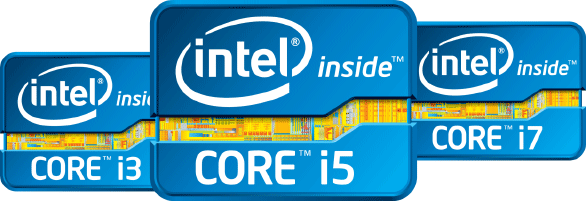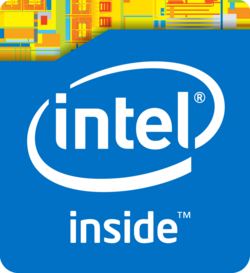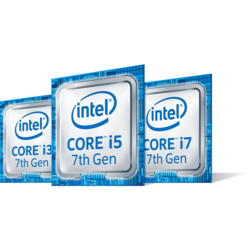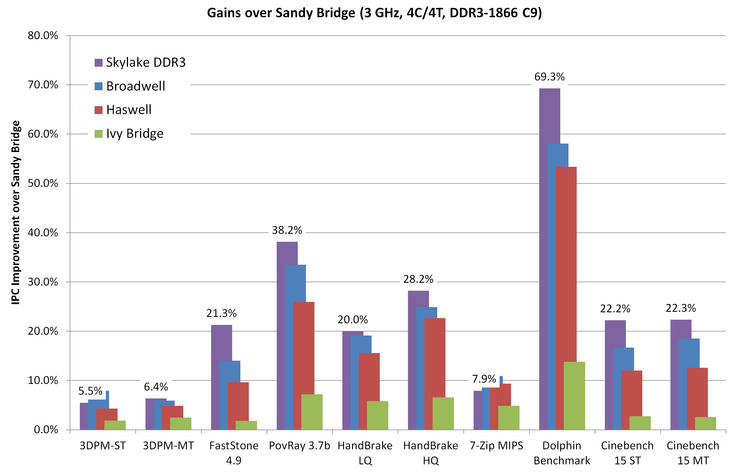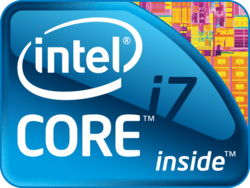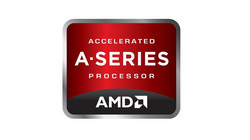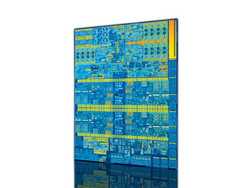Intel's Development over the Past Six Years
For the original German article, see here.
Intel recently introduced its new Kaby Lake processor generation, and like every year it glorified the significant improvements made to the new architecture. However, Intel is often accused of not making any real progress. We would like to pick up on this in the following special article by comparing Intel's latest processors. Here, both the desktop PC versions, as well as the models designed for the laptop market will compete against their counterparts from the previous generations, and we will examine to what extent the newest processors can outperform the older ones.
Products and Naming
First, a few facts about Intel's iX lineup: Intel introduced a new CPU series to both the stationary and mobile sector with its Intel Core iX range in 2010. Intel sells dual and quad-core processors in both the desktop and laptop divisions. Hyper-Threading is used in Intel's i3, i7, and since recently, the new Pentium desktop processors. The following is to provide a brief overview of the details:
Intel Core i7 traditionally stands for the manufacturer's premium-range models. All feature Hyper-Threading. Intel's Core i5 series represents the mid-range and is mainly aimed at casual gamers. Intel Core i5 quad-core processors are models exclusively for desktop PCs. The laptop models are either dual-core CPUs with Hyper-Threading or, also since recently, quad-cores without Hyper-Threading. Intel's Core i3s stand for the upper entry-level and are normally found in office computers. These always appear as dual-cores with Hyper-Threading in both the laptop and desktop PC sectors.
Technical Innovations
A lot seems to have changed - at least on paper. We will look at what impact this has in practice in the course of this article. The DDR3 RAM of the Skylake architecture in Intel's iX series has been replaced by DDR4 memory. Furthermore, the manufacturing process has been reduced from 32 nm to 14 nm. Processor integrated graphics cards came alongside Sandy Bridge, making it possible to run computers without an expensive dedicated graphics card. The clock rates and power consumption had apparently also been improved. The high-end model of the first generation, Intel's Core i7-870, was still delivered with 2.93 GHz (boost up to 3.60 GHz) and a TDP of 95 watts. Today, the smaller brother of the current premium-range model, Intel Core i7-6700, already provides better rates with a clock speed of 3.40 GHz (boost to 4.00 GHz) and a TDP of 65 watts.
Hyper-Threading technology introduced in 2010 should not go unmentioned. It allows processing two tasks simultaneously on one processor core. This can result in a considerable performance gain in applications that are optimized for utilizing all cores.
The statistic shows an IPC improvement of up to 70% from Skylake (with DDR3 RAM) compared to the 2011 Sandy Bridge architecture. IPC stands for Instructions Per Cycle, i.e. it describes the actual computing performance per MHz.
Benchmark Comparisons
It seems as if Intel has made some progress in the past years when looking at the spec sheets. We will now look at what impact these improvements have in practice based on some benchmarks. In the following, the same models from the different generations compete with each other in order to achieve a best as possible comparison.
Desktop Processors
A look at the benchmarks shows that the development in Intel's desktop sector has been sluggish at best. Intel's Core i7-7700k only outpaces the now five-year-old Intel Core i7-2600k by a good 46% in the Cinebench multi-core benchmark. This means that Intel's processors currently have an improvement rate of just 10% per year.
| Cinebench R15 | |
| CPU Single 64Bit | |
| Intel Core i7-7700K | |
| Intel Core i7-4790K | |
| Intel Core i7-2600K | |
| CPU Multi 64Bit | |
| Intel Core i7-7700K | |
| Intel Core i7-4790K | |
| Intel Core i7-2600K | |
Laptop Processors
A very similar image is seen when looking at the laptop sector. Intel's Core i7-7700HQ outperforms its Sandy Bridge counterpart (Intel's Core i7-2670QM in this case) by a good 56%. We again use the prevalent Intel i7 processors from each generation for comparison. We take the individual rates from our database. Thus, we decided to compare the processors here with the older Cinebench R10 benchmark since we do not have the newer R15 benchmark scores for the older processors.
| Cinebench R10 | |
| Rendering Single 32Bit | |
| Intel Core i7-7700HQ | |
| Intel Core i7-6700HQ | |
| Intel Core i7-4700MQ | |
| Intel Core i7-3630QM | |
| Intel Core i7-2670QM | |
| Rendering Multiple CPUs 32Bit | |
| Intel Core i7-7700HQ | |
| Intel Core i7-6700HQ | |
| Intel Core i7-4700MQ | |
| Intel Core i7-3630QM | |
| Intel Core i7-2670QM | |
Focusing on the benchmarks, we see that Intel's development in the laptop sector has also been very slow. Every new generation only surpasses the preceding one by 10%. The only rate that stands out is the leap from Sandy Bridge to Ivy Bridge (represented by Intel's Core i7-3630QM here). The successor could present an increase of almost 30% over its predecessor.
Reasons for this Development
A glance at other chip markets confirms that this is mainly due to Intel's development languor, e.g. in the graphics card division. Although this comparison is not really smooth since the tasks and the architectures of graphics cards and processors are fundamentally different, the gigantic progress in the graphics cards division proves that the development in the CPU market could be much faster. The situation also looks considerably better on the smartphone market. Here, in contrast to the laptop/desktop market, tremendous progress in the processors' efficiency and performance has been made. Samsung's Exynos 7420 outperformed the Snapdragon 801 by a good 70% in the multi-core benchmark although only one-and-a-half years separated the launch of both premium-range SoCs. Both SoCs belonged to the fastest SoCs on the market at their debut.
| Geekbench 3 | |
| 32 Bit Multi-Core Score | |
| Samsung Exynos 7420 Octa | |
| Qualcomm Snapdragon 801 MSM8974AC | |
| 32 Bit Single-Core Score | |
| Samsung Exynos 7420 Octa | |
| Qualcomm Snapdragon 801 MSM8974AC | |
The main reason for this development stagnation in the desktop PC processor market is primarily the lack of strong competition in the form of other manufacturers, e.g. AMD. After the flop of AMD's new processors in 2011/12, Intel could spread itself soundly over the market as AMD had not introduced a new architecture to the market. The announced AMD Ryzen architecture will likely change this soon.
The laptop market situation is even more extreme. While AMD at least provided a theoretical competition for desktop PCs, Intel could win over the entire market in the past years, at least in the mid-range and premium-range sectors. This is primarily because the last architecture by AMD involved very high power consumption, making the processors absolutely unsuitable for laptops. AMD processors are currently, if at all, exclusively found in entry-level laptops because AMD can still score with the good price-performance ratio of its APUs here.
Verdict
The sobering verdict is: Intel has only developed slowly over the past years. This is presumably because AMD did not manage to bring a reasonable alternative on the market after the failure of its Bulldozer architecture. Another fatal fact for the red competition is that the higher waste heat of AMD's processors actually eliminated them from the laptop market since the watt-performance ratio is often more important here than the only advantage that AMD has to offer: the price.
It must also be said here that Intel has sooner focused on the low TDP sector to make its processors more attractive for passively cooled ultrabooks/tablets in the past years. This is, however, not an excuse for the otherwise very sluggish development. It will be interesting to see what impact the upcoming release of AMD's processors has on the development of CPUs. Hopefully, AMD can keep its promise so that Intel once again has a serious competitor for its processors. As the saying goes: Competition is good for business.


